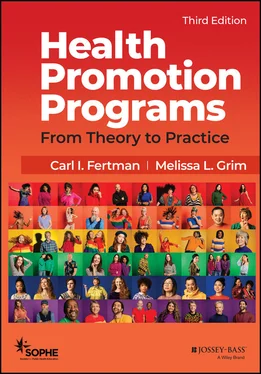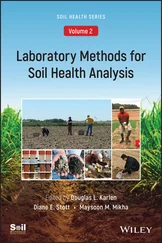(SOPHE) Society for Public Health Education - Health Promotion Programs
Здесь есть возможность читать онлайн «(SOPHE) Society for Public Health Education - Health Promotion Programs» — ознакомительный отрывок электронной книги совершенно бесплатно, а после прочтения отрывка купить полную версию. В некоторых случаях можно слушать аудио, скачать через торрент в формате fb2 и присутствует краткое содержание. Жанр: unrecognised, на английском языке. Описание произведения, (предисловие) а так же отзывы посетителей доступны на портале библиотеки ЛибКат.
- Название:Health Promotion Programs
- Автор:
- Жанр:
- Год:неизвестен
- ISBN:нет данных
- Рейтинг книги:5 / 5. Голосов: 1
-
Избранное:Добавить в избранное
- Отзывы:
-
Ваша оценка:
- 100
- 1
- 2
- 3
- 4
- 5
Health Promotion Programs: краткое содержание, описание и аннотация
Предлагаем к чтению аннотацию, описание, краткое содержание или предисловие (зависит от того, что написал сам автор книги «Health Promotion Programs»). Если вы не нашли необходимую информацию о книге — напишите в комментариях, мы постараемся отыскать её.
Health Promotion Programs: From Theory to Practice
Health Promotion Programs: From Theory to Practice
Health Promotion Programs — читать онлайн ознакомительный отрывок
Ниже представлен текст книги, разбитый по страницам. Система сохранения места последней прочитанной страницы, позволяет с удобством читать онлайн бесплатно книгу «Health Promotion Programs», без необходимости каждый раз заново искать на чём Вы остановились. Поставьте закладку, и сможете в любой момент перейти на страницу, на которой закончили чтение.
Интервал:
Закладка:
3 What do you think it would be like to work in a health promotion program? This chapter talks about health promotion programs in five settings—schools, workplaces, colleges and universities, healthcare organizations, and communities. Which setting is of most interest for you with regard to working in a health promotion program? What is attractive about this setting and the people in the setting? Who are the setting stakeholders?
4 What role does technology play in how you, family members, and friends promote your own health? How often do you use the Internet to find health information? What wearable technologies and apps do you use?
5 How do you navigate the societal forces (social justice and equity, technology, healthcare system, health is political) in the emerging health era to formulate and take action to promote the health of the individuals and communities for which you care and serve?
| KEY TERMS | |
| Advocate Advisory boards Champion Colleges and universities Communities Ecological health perspective Health Health education Health equity Health promotion Health promotion programs Health status Healthcare organizations Healthy People 2030 Interpersonal level | Intrapersonal level Jakarta Declaration Lalonde report Ottawa Charter Patient Protection and Affordable Care Act or Affordable Care Act (ACA) Population level Priority population Schools Settings Social Determinants of Health Social justice Stakeholders Workplaces World Health Organization |
References
1 Alber, J., Allegrante, J. P., Auld, M. E., & Breny, J. (2020). Looking back and moving forward: SOPHE’s 70 years of work in health education. Health Education and Behavior.
2 American College Health Association. (2020). Healthy campus framework. www.acha.org/HealthyCampus
3 Arnold, J., & Breen, L. J. (2006). Images of health. In M. O’Neill, S. Dupéré, A. Pederson, & I. Rootman (Eds.), Health promotion in Canada (2nd ed., pp. 3–20). Canadian Scholars’ Press.
4 ASCD®. (2021). ASCD whole child initiative. www.ascd.org/whole-child.aspx
5 Breslow, L. (1999). From disease prevention to health promotion. Journal of the American Medical Association, 281(11), 1030–1033. https://doi.org/10.1001/jama.281.11.1030
6 Chen, W. (2001). The relationship between health education and health promotion: A personal perspective. American Journal of Health Education, 32(6), 369–370. https://doi.org/10.1080/19325037.2001.10603499
7 Fertman, C. (2015). Workplace health promotion programs: Planning, implementation, and evaluation. Wiley.
8 Fidler, D. P. (2003). SARS: Political pathology of the first post-Westphalian pathogen. Journal of Law, Medicine and Ethics, 31(4), 485–505. https://doi.org/10.1111%2Fj.1748-720X.2003.tb00117.x
9 Green, L., & Kreuter, M. (1999). Health promotion planning: An educational and ecological approach (3rd ed.). Mayfield.
10 Green, L. W., Kreuter, M. W., Deeds, S. G., & Partridge, K. B. (1980). Health promotion planning: A diagnostic approach. Mayfield.
11 Kaplan, R., Spittel, M., & David, D. (Eds.). (2015). Population health: Behavioral and social science insights. AHRQ Publication No. 15-0002. Agency for Healthcare Research and Quality and Office of Behavioral and Social Sciences Research, National Institutes of Health.
12 Kickbush, I., & Payne, L. (2003). Twenty-first century health promotion: The public health revolution meets the wellness revolution. Health Promotion International, 18(4), 275–278.
13 Knowlden, A. P., Cottrell, R. R., Henderson, J., Allison, K., Auld, M. E., Kusorgbor-Narh, C. S., Lysoby, L., & McKenzie, J. F. (2020). Health education practice analysis II 2020: Process and outcomes. Health Education & Behavior. May 27:1090198120926923. https://doi.org/10.1177/1090198120926923. Online ahead of print.
14 Lalonde, M. (1974). A new perspective on the health of Canadians. Health and Welfare Canada.
15 Marmot, M. (2005). Social determinants of health inequalities. Lancet, 365(2005), 1099–1104. www.who.int/social_determinants/strategy/Marmot-Social%20determinants%20of%20health%20inqualities.pdf
16 McLeroy, K. R., Bibeau, D., Steckler, A., & Glanz, K. (1988). An ecological perspective on health promotion programs. Health Education Quarterly, 15(4), 351–377. https://doi.org/10.1177/109019818801500401
17 National Institute for Occupational Safety and Health. (2021). NIOSH total worker health program. www.cdc.gov/niosh/twh/default.html
18 OER. (2020). https://courses.lumenlearning.com/suny-diseaseprevention/chapter/types-of-health-care-professionals-and-facilities/
19 Perdue, W. C., Gostin, L. O., & Stone, L. A. (2003). Public health and the built environment: Historical, empirical and theoretical foundations for an expanded role. Journal of Law, Medicine and Ethics, 31(4), 557–566. https://doi.org/10.1111%2Fj.1748-720X.2003.tb00123.x
20 Prescott, B. T. (2019). Recent trends in several key metrics in higher education. Change: Magazine of Higher Learning, 52(1), 22–27. https://doi.org/10.1080/00091383.2019.1547075
21 University of Wisconsin Public Health Institute & Robert Woods Johnson Foundation. (2021). Population health management: systems and success. www.healthcatalyst.com/population-health
22 U.S. Department of Health and Human Services. (1979). Healthy people: The surgeon general’s report on health promotion and disease prevention. Author.
23 U.S. Department of Labor, Bureau of Labor Statistics (2020a). Occupational Outlook Handbook, 2020–2021 Edition, Health Educators and Community Health Workers. www.bls.gov/ooh/community-and-social-service/health-educators.htm
24 U.S. Department of Labor, Bureau of Labor Statistics (2020b). Occupational Outlook Handbook, 2020–2021 Edition, Healthcare Occupations Outlook. www.bls.gov/ooh/healthcare/home.htm
25 World Health Organization. (1947). Constitution of the World Health Organization. Chronicle of the World Health Organization, 1(1–2), 29–43. www.who.int/governance/eb/who_constitution_en.pdf
26 World Health Organization. (1986). The Ottawa charter for health promotion. Canadian Public Health Association.
27 World Health Organization. (1997, July 21–25). Jakarta declaration on leading health promotion into the 21st century. Fourth International Conference on Health Promotion: New Players for a New Era—Leading Health Promotion into the 21st Century, Jakarta, Indonesia.
28 World Health Organization. (1998). Health promotion glossary. WHO/HPR/HEP/98.1 Distr.: Limited. www.who.int/healthpromotion/about/HPR%20Glossary%201998.pdf
CHAPTER 2 HEALTH PROMOTION, EQUITY, AND SOCIAL JUSTICE
Holly E. Jacobson, Francisco Soto Mas, and Laura L. Nervi
LEARNING OBJECTIVES
Explain the intersection of health promotion, equity, and social justice.
Describe how health status and healthcare vary among individuals and groups of people within the same community.
Identify actions health promotion programs take to advance health equity and social justice.
Summarize how the Health in All Policies guideline created conditions to facilitate greater health equity and social justice.
Health Promotion, Equity , and Social Justice Intersection
Effective health promotion programs strive to promote health equityand social justice. Health equity means that everyone has a fair and just opportunity to be as healthy as possible. This requires removing obstacles to health such as poverty, discrimination, and their consequences, including powerlessness and lack of access to good jobs with fair pay, quality education and housing, safe environments, and healthcare. Health equity means reducing and ultimately eliminating disparities in health and its determinants that adversely affect excluded or marginalized groups. Social justice is the view that everyone deserves equal rights and opportunities—this includes the right to good health. Yet today there are inequities in health that are avoidable, unnecessary, and unjust. These inequities are the result of policies and practices that create an unequal distribution of money, power, and resources among communities based on race, class, gender, place, and other factors.
Читать дальшеИнтервал:
Закладка:
Похожие книги на «Health Promotion Programs»
Представляем Вашему вниманию похожие книги на «Health Promotion Programs» списком для выбора. Мы отобрали схожую по названию и смыслу литературу в надежде предоставить читателям больше вариантов отыскать новые, интересные, ещё непрочитанные произведения.
Обсуждение, отзывы о книге «Health Promotion Programs» и просто собственные мнения читателей. Оставьте ваши комментарии, напишите, что Вы думаете о произведении, его смысле или главных героях. Укажите что конкретно понравилось, а что нет, и почему Вы так считаете.












